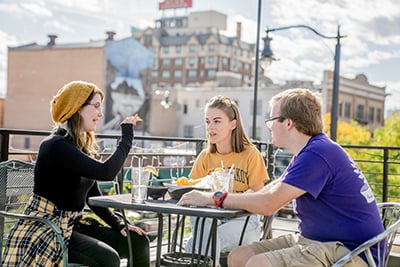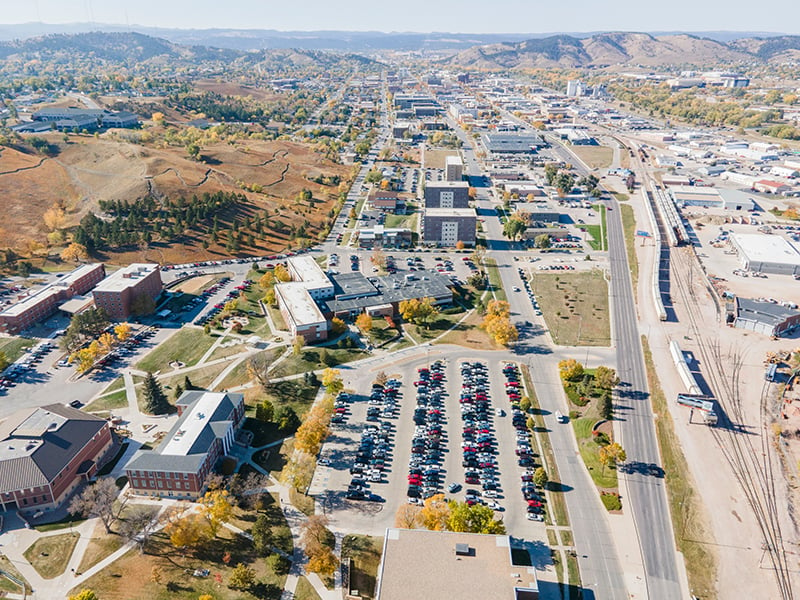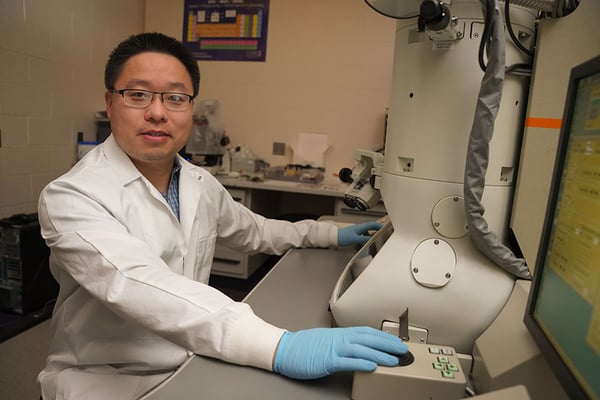An area of booming high-tech economic development around South Dakota Mines envisioned in 2016 by city, business, and university leaders is coming to life. Major changes are underway for the “Innovation District” corridor between South Dakota Mines and Downtown Rapid City. The district is growing in the number of engineering and high-tech businesses that are already providing a range of tech industry jobs with a local economic impact measured in millions.
“You start to do the math and by the end of this year we will have close to 100 tech jobs in the corridor between downtown and Mines. Back in 2016 when we started this, there were no tech jobs in this area,” says Darren Haar, who chairs the board of directors for Elevate Rapid City. “When you look around at what is happening, it’s a little bit of an epiphany, this is all coming together in a big way and the future is really exciting.”
A conservative estimate for average salary for established high-tech workers is $70,000, which means the district is already having an $7 million economic impact in wage earnings alone. This number is expected to climb as the district continues to grow.
South Dakota Mines is a hub of tech-based economic development in the Black Hills. Mines President Jim Rankin, (EE 78), PhD, PE, says this is all tied of the ongoing effort to turn research at Mines into jobs right here in the state. “Our students and faculty are highly innovative, and we have multiple new patents filed each year. We’re harnessing this ingenuity to build cutting-edge industry right here in the Black Hills.”
A Blooming High-Tech Corridor: With Places to Live, Work and Play.
By the start of 2023, 150 brand new housing units are expected to be open in the Innovation District alone; this includes The Elements building with loft style apartments on St. Joseph Street and The Kansas City Street Lofts above Dream Design International. The Block 5 development in the center of downtown will bring an additional 130 housing units to the vicinity. These new housing units can help the city alleviate the overall housing shortage by freeing up other rental units now occupied in other neighborhoods around town.
“This is all so exciting to see,” says Sarah Hanzel, the Rapid City planning projects division manager who was one of the instrumental players in the development of the Innovation District. “It’s really wonderful to think back to those public meetings in 2016 and remember those empty parking lots that now have buildings on them. This is all thanks to the vision of everyone involved. It is thanks to our community and the collaboration we have maintained.”
Some of the high-tech businesses now located in and around the Innovation District include AE2S, Affordable Creative Engineering Services, Dream Design International, Foth Engineering, Innovative Materials and Processes, Omnitech, Property Meld, Project Solutions, Skyline Engineering, and more. The David Lust Accelerator Building houses a multimillion-dollar incubator that just welcomed seven new companies. The model has a proven track record of high-tech job creation by launching companies spurred from research at South Dakota Mines or housing satellite offices and new high-tech companies from outside of the area who capitalize on the pipeline of talent from Mines. The Garage co-working space provides additional resources for a range of professionals and organizations.
“The Innovation District demonstrates a community commitment to fostering technology and innovation in our city,” says Mitch Nachtigall, innovation and entrepreneurship director at Elevate Rapid City. “The connection between downtown, the David Lust Accelerator Building, and Mines creates an ecosystem for growth and prosperity that is so important to Rapid City’s future.”
All of the firms in the Innovation District are tied to several other high-tech enterprises in the Black Hills area such as RESPEC, Phase Technologies, B9Creations, VRC Metal Systems, Novum Nano, DARCEO, C-Lock, H-S Precision, the Sanford Underground Research Facility (SURF) and ongoing innovation around Ellsworth Airforce Base, the new B-21 Raider, and many more.
“Mines’ ongoing work with Ellsworth, the National Security Innovation Network and other Department of Defense facilities around the nation is a huge component to future high-tech growth here in the Hills. The massive projects underway at SURF are an additional area of major job growth for this region,” says President Rankin. “When you combine all of this together, the opportunities in and around our community are really impressive.”
 Downtown Rapid City’s Main Street Square, new Monument Summit Arena, and all the amenities, shops, diners, restaurants, and pubs in Downtown Rapid City provide recreation and leisure opportunities and events year-round. The lighting improvements completed between downtown and the Mines campus offer increased safety at night. The newly opened Rocker Trail above South Dakota Mines along with local trails on M-Hill and Skyline Drive connected by the city’s extensive bike path provide ample recreation opportunities. The outdoor activities available in the surrounding Black Hills and Badlands area provide an edge over other state and regional cities that will continue to attract and retain the best and brightest talent.
Downtown Rapid City’s Main Street Square, new Monument Summit Arena, and all the amenities, shops, diners, restaurants, and pubs in Downtown Rapid City provide recreation and leisure opportunities and events year-round. The lighting improvements completed between downtown and the Mines campus offer increased safety at night. The newly opened Rocker Trail above South Dakota Mines along with local trails on M-Hill and Skyline Drive connected by the city’s extensive bike path provide ample recreation opportunities. The outdoor activities available in the surrounding Black Hills and Badlands area provide an edge over other state and regional cities that will continue to attract and retain the best and brightest talent.
An Open Door to an Exciting Future
Possibilities for the Innovation District area include new infrastructure plans and improvements such as restaurants, expanded office spaces, shops, more housing for all income levels including students, and possible conversion of some alleyways in the district into pedestrian corridors with shops, outdoor dining, and beer gardens.
“The Innovation District will be a mixed-use urban core that we hope will be transformative for Rapid City,” says Garth Wadsworth, Elevate Rapid City public policy director. “We’re going to have a combination of tech offices, advanced manufacturing facilities, and downtown living spaces all within a pedestrian and bicycle-friendly environment. People will have access to all the amenities and job opportunities within walking distance.”
The success of this effort so far deserves accolades, and the future holds even more exciting potential. “Vision is not a static thing, and what we create is a constant moving target,” says Hanzel. “We’ve built great partnerships between Mines, the city, and our local businesses and this ongoing collaboration will yield amazing opportunities in the community.”
City officials note there are multiple financing tools that can assist in a range of public infrastructure improvements. For many, the future of this part of Rapid City is very bright.
“We are making this part of town a fantastic place to live, work, and play. You won’t recognize this place with all the development and changes coming in the next five to ten years,” says Haar.
A Credit to Visionary Leadership
The current movement towards development of this area had its beginnings in 2014, when a group of community members opened The Garage co-working space, which brought energy and attention to the District and a range of professionals and organizations. The “East of 5th” group that formed around that time also helped spur the idea of an innovation district between Mines and downtown.
In 2016, community leaders published the Rapid City Downtown Area Master Plan. The city council, planning commission, county commissioners, local business leaders, and South Dakota Mines officials helped create the plan with ample public input.
“I’m not aware of a single entity or moment in time that the innovation district came to be,” says Hanzel. “The idea originated from many places at once; it was everywhere. We were developing the downtown master plan, there was the East of 5th neighborhood group, grass-roots community champions, and many people involved from Mines.”
The market assessment tied to the master planning process called for 200 to 400 new housing units downtown. “This was eye opening to us,” says Hanzel. To meet the goals of the master plan, rezoning was needed. That effort took city officials about a year and a half. In the end, the new urban commercial zoning added to the East of 5th area streamlined the development process and encouraged pedestrian friendly mixed-use housing and commercial projects, some of which are now under construction. “I’m proud of our community for taking the leaps of faith with these policy changes,” says Hanzel.
"Today's Innovation District grew organically, very much the result of local people interested in building community. There were under-utlized buildings rich with history and possibility, and visionaries who were willing to take risk and action to bring those buildings to life and bring businesses and nonprofits to the District," says Matt Ehlman, Ph.D., principal of The Numad Group and a developer of five new spaces in the District, including the recent Property Meld building on St. Joseph Street. "South Dakota Mines has been an important partner from the beginning, and it's exciting to see increased focus from Mines, the City, and the businesses and residents in the neighborhood. There is so much potential to grow businesses and hire and retain smart graduates from Mines."
A short six years after the 2016 master planning process, the Innovation District envisioned around South Dakota Mines is beginning to flourish. “It’s starting to really feel different in this area,” says Hanzel.
“We really need to give credit to so many people in the public, private, and university sectors who have come together to make this all happen,” says Haar.
“Rapid City is a unique community in the Midwest, as we are more like a western mountain biking and recreation hub of the region. As entrepreneurship and startup companies continue to grow in the region, creating jobs and diversifying the tax base, quality of life must continue to be a priority strategy for Rapid City,” explains Tom Johnson, president and CEO of Elevate Rapid City. “The innovation district allows people the opportunity to live and work and visit brew pubs in the same neighborhood.”


.jpg?width=600&height=450&name=Michelle%20and%20Danni%202023%20(003).jpg)
